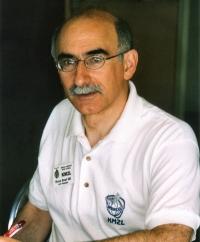Hi Everyone,
I joined MARCO last spring after seeing your booth at Dayton. I'm an RN in
a cardiac unit for my 'day job'. Another one of my 'nite job' activities is
as the news editor for AMSAT ... The bunch that builds and launches
satellites.
At the AMSAT Syposium this past weekend we learned that AMSAT has been
offered an opportunity for a ride to geosychronous orbit. I've attached the
AMSAT News Service Bulletin below.
It will still take a couple of years to get up there. But think of the
emergency service capability a geosynchronous satellite can add to the
amateur service!
--
73 de JoAnne K9JKM
k9jkm@amsat.org
SB SAT @ AMSAT $ANS-301.01
The Weekend That Changed Amateur Radio
AMSAT News Service Bulletin 301.01
>From AMSAT HQ SILVER SPRING, MD.
October 28, 2007
To All RADIO AMATEURS
BID: $ANS-301.01
This past weekend, October 26-28 AMSAT-NA held a very successful Space
Symposium in Pittsburgh, Pennsylvania.
Rick Hambly, W2GPS, AMSAT President along with Bob McGwier, N4HY, AMSAT
Vice-President of Engineering were able to make public the results of
their recent work which will change the face of amateur radio going
forward. AMSAT has been in consultation with Intelsat regarding an
application of an Intelsat platform carrying our amateur radio satelites
into geosynchronous orbit.
Engineering studies, funding studies, among other negotiations are
continuing at this point. However Bob, N4HY made the following obser-
vation of the project AMSAT has termed Phase IV Lite, "There is enough
in place at this time that AMSAT needs to begin planning engineering
work and possible construction of a geosychronous payload so we are
ready if Intelsat says they have a ride for us."
The Phase IV Lite Geosynchronous Payload is planned to consist of
similar transponders already under development for the Phase 3 satel-
lites. Accelerated development on the digital Advanced Communica-
tion Package is anticipated. In addition to the communication pay-
load flown to space, AMSAT plans to develop an earth station attain-
able by the average ham so that users can immediately take advantage
of the audio, digital messaging, and video services.
The Advanced Communication Package would be a self-contained earth
station which could be sent with amateur radio communication teams
or delivered to disaster areas for 24/7/365 emergency communications.
These teams would be able to point a small dish at a predictable
spot in the sky and immediately begin delivering disaster commun-
ication support without depending on HF propagation.
A Phase IV payload could also be used to provide TDRSS-like relay
of ARISS communications. The 10 minute school contact could now
be expanded to hours-long contact with the International Space
Station. This opens possibilities for student involvement with
experiments aboard the space station.
The Intelsat geosynchronous platform would be able to provide the
AMSAT Phase IV Lite payload with approximately 400 watts of DC
power for 15 years. The primary payload would also perform the
GTO boost phase as well as perform station keeping and antenna
pointing once it has arrived on station. Bob, N4HY summarized,
"The Intelsat team would be doing all the things nearly impossible
for amateurs and that enables AMSAT to do what we do best ... build
a communication system that changes amateur radio for the better!"
More details will be published in upcoming editions of the AMSAT
Journal.
[ANS thanks Rick, W2GPS and Bob, N4HY for the above information]
/EX
We received an interesting reply from Jay Garlitz, AA4FL:
JoAnne, thanks for sharing the AMSAT information with the group. I am
curious how many of us are AMSAT members?
One note about satellite ops is that we have a satellite station at W4DFU in
the Shands Hospital/Health Center complex at the University of Florida.
Satellite and echolink are the equipment used most often and attracts new
hams. MARCO is an HF centric group and that is generational/traditional.
These other modes are getting new members in the door and we then excite
them about HF. (see www.gatorradio.org)
Please accept my comments as a possible way to attract younger health
professionals to the hobby, and to our ranks.
73's Jay, AA4FL (AMSAT member)

No comments:
Post a Comment